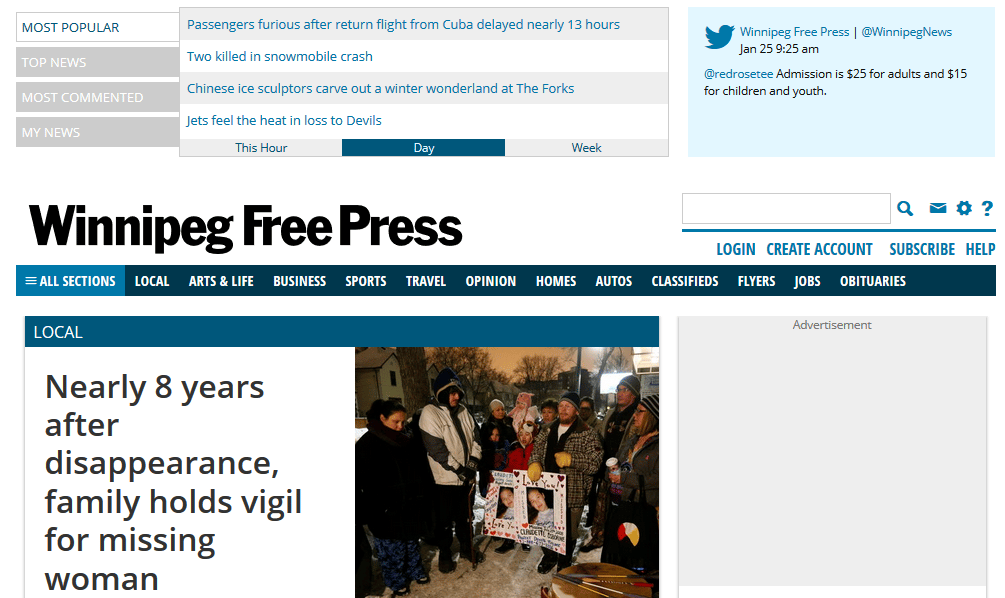
Winnipeg Free Press Experiences Early Success with Micropayments
Lorem ipsum dolor sit amet, consectetur adipiscing elit. Ut elit tellus, luctus nec ullamcorper mattis, pulvinar dapibus leo.
Source: Winnipeg Free Press

Seven months in, the Winnipeg Free Press is enjoying early success with its new micropayment strategy, even exceeding the newspaper’s goals and expectations. The process started about 18 months ago when the newspaper realized, despite a growing digital audience, that its digital advertising revenue was not sufficient to compensate for the erosion of its print audience.
“We got to a point where we couldn’t wait and watch any longer,” said Christian Panson, vice president, digital. “Free was just not an option for us anymore.”
Before deciding what type of monetization strategy to implement, the Free Press wanted to better understand its audience. They had very little data about their print subscribers and only aggregate analytics fo their digital audience, so the first step was to collect qualitative and quantitative data from both groups. They partnered with Cxense, deploying an analytics package and a log in wall to get the information they needed.
Initially, readers had the option to skip the log in process, but over the course of six to eight weeks, they were eventually required to log in. They were hoping for 70,000 log-ins, but actually got 180,000, giving them tons of data with which to work. They learned their audience was three-fold:
- One-and-done readers who were unlikely to pay for the Free Press regardless of the monetization strategy
- Returning readers who might not hit a meter every month, but who will come back regularly
- Loyalists who read hundreds of articles every month and who could be monetized in some way.
After much consideration, the Free Press chose to go with a monetization strategy that addressed each audience’s needs – a low metered environment for the one-and-dones, a Read Now Pay Later micropayment model for returning readers, and print and all-access digital subscriptions for loyalists. The Free Press already had a low metered environment with its log in system and subscriptions for its loyal readers, so it only needed to add the micropayment solution to its existing strategies.
Source: Winnipeg Free Press

Next on the “to do” list was designing the Read Now Pay Later micropayment solution. They selected a vendor, MPP Global, who would partner with the Free Press without getting in between the Free Press and their customers and who could implement a solution that was post-pay. The Free Press priced the micropayments at $0.27 (Canadian) per article, set up a 30-day free trial, and implemented a refund system so readers wouldn’t have to pay for articles they didn’t feel were a good value.
Along with a site redesign and content personalization, the Free Press launched the new micropayment strategy last July and has had great results thus far. Here are some of the highlights shared by MPP Global and the Free Press in a webinar last Wednesday:
- 20% increase in the time each reader spent with each piece of content
- 87% increase in page views per user, almost double the previous total
- 124% increase in user duration, breaking the 10-minute mark for the first time in 8 years
- Print erosion fell by nearly 50%
- 45% of print subscribers activated their online access, increasing their engagement
“We traveled a huge, huge distance in a short amount of time,” Panson said.
While there are many lessons for other publishers to learn, Panson offered three key takeaways:
- Always focus on the reader, and do what’s right for them first. Rewards will come back to you.
- Reduce barriers to commitment, like pre-loaded wallets. Be honest with yourself and ask yourself what barriers exist between you and your customer. Do whatever it takes to eliminate barriers.
- Use audience data to personalize their experience. Give them the content they want, when they need it, and in the fashion that they want it.
Insider Take:
As MPP Global Senior Vice President, North America, Scott O’Neill pointed out in last week’s webinar, a micropayment strategy won’t work for every publisher, but in this case, the Free Press has done well with it.
The success of the solution is no accident, however. The Free Press put a great deal of thought into it, carefully analyzing reader data, creatively designing a workable solution that met each of its audience’s needs, and thoughtfully implementing and adjusting the strategy to make it easy for its readers to adapt to. We’re excited to see how well the Free Press’s audience has responded, and we’re eager to watch as the solution evolves over time.
For a detailed look at the Free Press’s monetization and personalized content strategies, please read our in-depth case study available at SubscriptionInsider.com. In the case study, O’Neill and Panson share significant information into the monetization and design process from conception to implementation, and we offer seven additional takeaways for publishers to learn from. Note: the 10-page case study is available to members only.




